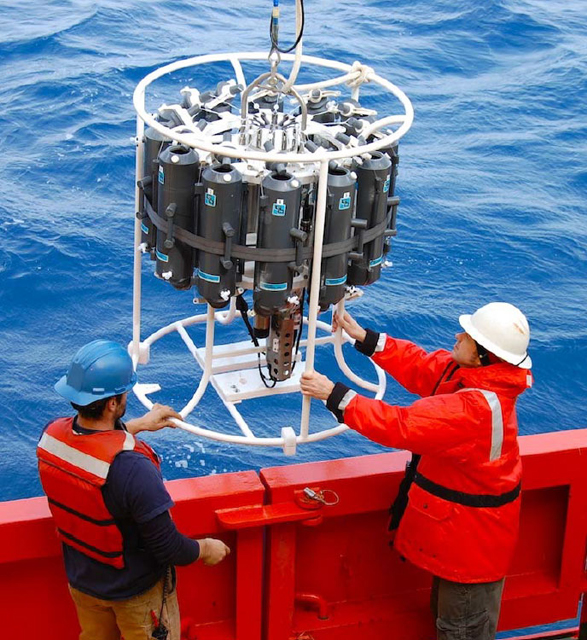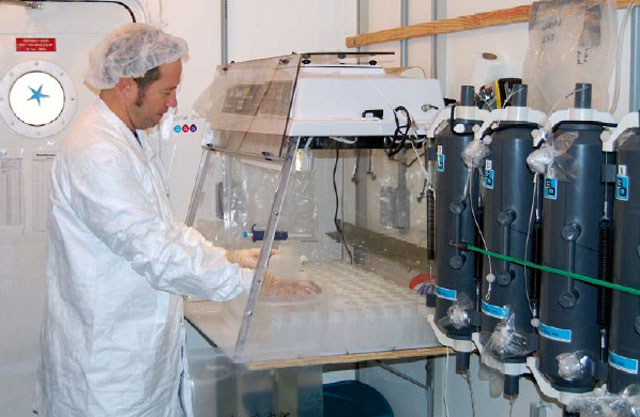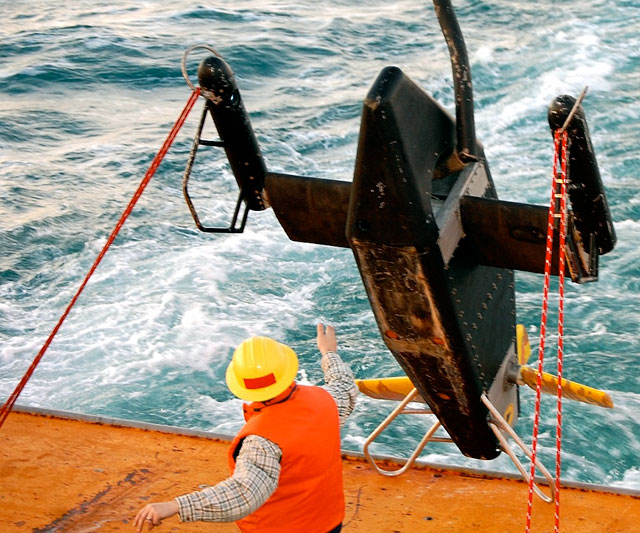|
Page 2/2 - Posted May 25, 2012
PRISM expedition conducts broad scale study of zooplanktonJohn Klinck “The combination of temperature, salinity and dissolved oxygen is indicative of where the water comes from,” Klinck explains. For example, low levels of oxygen indicate a water mass that was below the surface for a long time, perhaps centuries. A temperature of minus 1 degree Celsius suggests ocean water that has been on the continental shelf for a while. 
Photo Credit: Stephanie Hathcock
Peter Sedwick and Dan Powers deploy the trace- metal clean CTD/rosette.
“The measurements [we took were] much closer together than traditional measurements, and we found small eddies and structures that had been missed before,” Klinck said. “We got a much higher resolution picture of what is there, and the iron measurements were clearly the new part of what we were doing.” Those iron measurements were made by a different CTD rosette system, a so-called trace metal CTD, which does not contain any exposed iron in its construction, which could skew the results. “Having that trace-metal clean [CTD] was an absolute necessity,” McGillicuddy said. A different sort of water column profiling device called a SeaHorse also proved invaluable, according to McGillicuddy. While the SeaHorse makes similar measurements to a CTD and other shipboard instruments, it can be deployed independently from the research vessel, left to make continuous measurements in one vertical column in the water. A cable descends from a surface buoy, with weights at the bottom to keep it anchored in place. Ocean wave action propels the instrument package down the tether to the bottom, where positive buoyancy drives it back up the line. “It’s a really, really nice instrument,” McGillicuddy said. “We got a nice time series in both drifting mode and also moored on top of the Ross Bank.” The SeaHorse was provided and operated by a team led by Blair Greenan, a senior scientist at Fisheries and Ocean Canada An altogether different instrument called a video plankton recorder (VPR) “flew” behind the Palmer for hours a time. A digital camera in the nosecone of the VPR, which sports a strobe on the starboard wing, took 30 photographs per second. Its computer can identify organisms in the water. Other sensors aboard the VPR measure the physical ocean properties of the water and plankton. The VPR measurements were of particular interest to the PRISM biologists, led by Walker Smith “We will be working very hard to merge those datasets to understand the mesoscale distribution of phytoplankton in these areas,” Smith said. The biologists also conducted net tows to capture a larger class of marine organisms called zooplankton, which includes krill, to assess their distribution and biomass in the Ross Sea. “We collected a whole series of zooplankton, which may represent one of the few broad scale attempts at understanding the distribution of zooplankton in different forms and therefore understand the food web a little better,” Smith said. Data on iron distribution and biological productivity from the PRISM project are particularly important as scientists build a baseline of the current conditions in the Ross Sea. The region is expected to change as the global climate shifts. McGillicuddy said it’s too early to offer any specific predictions on how climate change might affect primary productivity in the Ross Sea at this time. “We’re just now trying to come up with a better understanding of what’s providing iron in the Ross Sea,” he said. “I think understanding those mechanisms will provide us a basis on which to make predictions on how things will change in the future.” NSF-funded research in this article: Dennis McGillicuddy, Woods Hole Oceanographic Institution, Award No. 0944165 |



For USAP Participants |
For The Public |
For Researchers and EducatorsContact UsNational Science FoundationOffice of Polar Programs Geosciences Directorate 2415 Eisenhower Avenue, Suite W7100 Alexandria, VA 22314 Sign up for the NSF Office of Polar Programs newsletter and events. Feedback Form |



